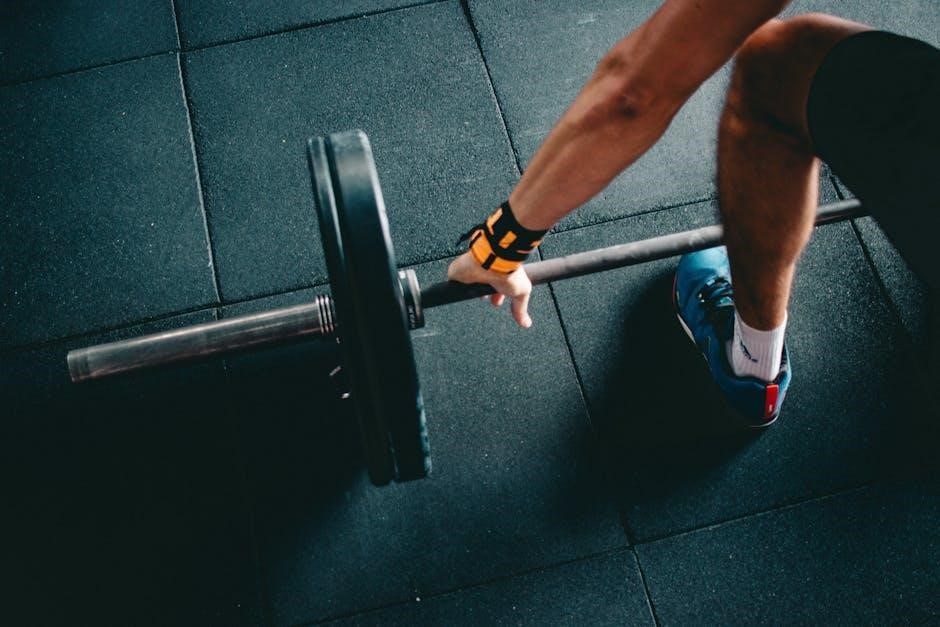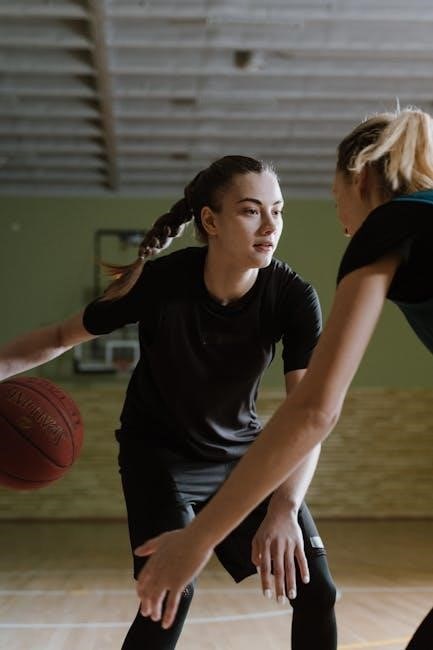
Basketball weight training is essential for enhancing performance‚ preventing injuries‚ and building athleticism. A well-structured program focuses on strength‚ power‚ speed‚ and agility‚ helping players achieve their full potential on the court. Consistency and proper execution are key to success.
1.1 Importance of a Weight Training Program
A well-structured weight training program is crucial for basketball players to enhance performance‚ prevent injuries‚ and achieve long-term athletic development. It improves strength‚ power‚ speed‚ and agility‚ which are essential for success on the court. By focusing on specific muscle groups‚ players can build a balanced physique‚ reducing the risk of injuries and improving durability. Consistency in weight training also enhances endurance and explosiveness‚ allowing players to maintain high-intensity efforts throughout the game. Additionally‚ a weight training program helps athletes recover faster between games and practices‚ ensuring optimal performance. Proper periodization of training cycles‚ such as mass‚ strength‚ and power phases‚ ensures progressive overload and continuous improvement. Overall‚ a basketball weight training program is a cornerstone for developing a strong‚ resilient‚ and high-performing athlete.

Off-Season Training Program

The off-season training program is crucial for building muscle and strength‚ spanning from post-season to August. It includes mass‚ strength‚ and power cycles to enhance physical preparation and improve performance‚ preventing injuries for the upcoming season.
2.1 Mass Cycle
The mass cycle is the first phase of the off-season training program‚ lasting approximately 7 weeks. Its primary goal is to increase muscle mass and overall strength‚ which is essential for basketball players to handle physicality on the court. During this phase‚ players focus on high-intensity weightlifting exercises such as squats‚ bench presses‚ and deadlifts. These exercises target major muscle groups like the legs‚ chest‚ and back‚ which are critical for explosiveness and endurance. Additionally‚ the mass cycle incorporates compound movements that promote muscle hypertrophy‚ helping players build a solid foundation for the upcoming strength and power phases. Proper nutrition and recovery are emphasized to support muscle growth‚ ensuring players can safely progress through the program and achieve their goals. This phase sets the stage for the more specialized training that follows in the strength and power cycles‚ making it a cornerstone of the off-season regimen.

2.2 Strength Cycle
The strength cycle is the second phase of the off-season program‚ typically spanning weeks 8-14. This phase focuses on maximizing muscular strength‚ which is crucial for basketball players to dominate in rebounding‚ defense‚ and physical play. The training involves higher intensity and lower volume compared to the mass cycle‚ with exercises like bench presses‚ squats‚ and deadlifts performed at 70-85% of one-rep max. Players aim for 3-5 sets of 3-6 repetitions‚ focusing on progressive overload to continually challenge their muscles. Accessory exercises such as pull-ups‚ lunges‚ and overhead presses are also included to improve overall athleticism and stability. The strength cycle builds on the muscle mass gained in the mass cycle‚ preparing players for the explosive demands of basketball. Proper recovery and nutrition remain critical to support strength gains and prevent overtraining. This phase is essential for developing the raw power needed to excel on the court‚ setting the foundation for the upcoming strength and power cycle. Consistency and attention to form are key to achieving desired results.
2.3 Strength and Power Cycle
The strength and power cycle is the final phase of the off-season program‚ typically lasting from week 15 to week 19. This phase combines the foundational strength developed in the previous cycles with explosive power‚ preparing players for the dynamic demands of basketball. The focus shifts to exercises that enhance neuromuscular coordination‚ such as power cleans‚ snatches‚ and box jumps‚ which improve explosiveness and speed. Players also incorporate plyometric drills like depth jumps and burpees to further develop vertical and lateral explosiveness. The intensity remains high‚ with loads ranging from 70-85% of one-rep max‚ but the volume is slightly reduced to prioritize quality over quantity. This cycle also introduces sport-specific movements‚ such as weighted sprints and agility drills‚ to bridge the gap between strength and basketball performance. By the end of this cycle‚ players should notice significant improvements in their ability to explode off the ground‚ accelerate quickly‚ and change direction on the court. Proper recovery and form are emphasized to ensure peak performance and minimize injury risk. This phase is critical for translating off-season gains into in-season success.

Pre-Season Training Program
The pre-season training program is designed to prepare basketball players for the upcoming season by refining strength‚ enhancing speed‚ and improving agility. This phase typically begins in August and lasts until mid-October‚ focusing on sport-specific movements and high-intensity conditioning. Players transition from the off-season’s strength and power cycles to more dynamic and explosive exercises‚ such as box jumps‚ depth jumps‚ and sprints. The program also incorporates agility drills like ladder exercises and cone drills to improve quickness and change-of-direction speed.
Conditioning is a key component‚ with the introduction of high-intensity interval training (HIIT) to simulate game-like scenarios. Strength sessions are reduced to 2-3 times per week‚ with a focus on maintaining muscle mass and functional strength. Players also engage in sport-specific workouts‚ such as weighted sprints and resistance band exercises‚ to enhance power and endurance. The goal of the pre-season program is to ensure players are physically and mentally prepared for the demands of competition‚ with a strong emphasis on injury prevention and peak performance. This phase sets the foundation for in-season success.
In-Season Training Program
The in-season training program is designed to maintain strength‚ endurance‚ and explosiveness while minimizing fatigue. This phase focuses on preserving the athletic gains made during the off-season and pre-season‚ ensuring players remain competitive and injury-free. Workouts are typically reduced to 2-3 times per week‚ with a focus on sport-specific movements and recovery.
Players engage in low-intensity conditioning‚ such as low-intensity cardio and dynamic stretching‚ to maintain stamina without overtaxing their bodies. Strength sessions emphasize functional exercises‚ such as bodyweight squats and resistance band rows‚ to maintain muscle mass and strength.
Recovery is a critical component‚ with strategies like foam rolling‚ mobility drills‚ and nutrition optimization being prioritized. The program is tailored to complement game schedules‚ ensuring players are fresh and prepared for competition. The goal is to sustain performance levels throughout the season while minimizing the risk of injury. This phase is essential for long-term success and peak performance.
Key Components of the Program
The program emphasizes core strength‚ dynamic stretching‚ and plyometrics to enhance explosiveness and mobility. Functional exercises and injury prevention are also prioritized to ensure overall athleticism and durability for basketball performance.
5.1 Core Strength and Stability
Core strength and stability are foundational to any basketball weight training program. A strong core improves balance‚ posture‚ and overall athletic performance. Exercises like planks‚ bird dogs‚ and Russian twists target the abdominals‚ obliques‚ and lower back muscles. These movements enhance rotational power‚ essential for shooting and driving. Additionally‚ core stability reduces the risk of injuries by providing a solid base for explosive movements. Dynamic exercises‚ such as medicine ball tosses and rotational med ball throws‚ further develop functional strength. Incorporating superman and side plank variations strengthens the erector spinae and glutes‚ critical for maintaining proper form during jumps and sprints. A well-developed core also improves endurance‚ allowing players to sustain high-intensity efforts throughout the game. By prioritizing core strength‚ athletes can enhance their stability‚ coordination‚ and overall effectiveness on the court. Consistency in core training is vital for long-term success in basketball.
5.2 Dynamic Stretching and Mobility
Dynamic stretching and mobility exercises are crucial for preparing the body for basketball’s demands. They enhance flexibility‚ range of motion‚ and muscle activation‚ reducing injury risk. Exercises like high knees‚ butt kicks‚ and leg swings improve joint mobility and warm up the muscles. Arm circles and torso twists increase upper body flexibility and rotational movement. Incorporating lateral lunges and carioca drills enhances agility and balance. Mobility drills‚ such as hip openers and ankle mobilizations‚ are essential for maintaining proper movement patterns. These exercises should be performed before workouts and games to optimize performance. Consistent dynamic stretching improves overall athleticism and ensures players can move efficiently on the court. By focusing on mobility‚ athletes can maintain flexibility and reduce muscle stiffness‚ which is vital for explosive movements like jumping and sprinting. Dynamic stretching is a cornerstone of any effective basketball training program‚ laying the groundwork for strength and power development.
5.3 Plyometrics and Explosiveness
Plyometrics and explosiveness training are vital for basketball players‚ focusing on enhancing jump height‚ speed‚ and power. Exercises like box jumps‚ broad jumps‚ and depth jumps improve explosive force and reactive strength. Tuck jumps and burpees increase vertical leap and overall athleticism. Lateral box jumps and zig-zag hops enhance agility and lateral explosiveness. These drills mimic game situations‚ such as sprinting down the court or jumping for rebounds. Plyometric training also improves neuromuscular coordination‚ allowing for faster and more powerful movements. Incorporating medicine ball throws and slam dunks can further develop explosive upper body strength. Consistency in plyometric exercises translates to better performance on the court‚ enabling players to dominate in rebounds‚ dunks‚ and fast breaks. By building explosiveness‚ athletes gain a competitive edge‚ making plyometrics an essential component of any basketball weight training program.

A well-structured basketball weight training program is essential for achieving peak performance and maintaining a competitive edge. By focusing on strength‚ power‚ speed‚ and agility‚ players can enhance their overall athleticism and durability. The integration of plyometrics‚ core strength‚ and mobility ensures a comprehensive approach to physical development. Consistency and proper execution of these exercises are crucial for maximizing results. Athletes who commit to such programs often see significant improvements in jump height‚ acceleration‚ and endurance‚ which directly translate to better performance on the court. Additionally‚ a well-designed program helps prevent injuries and prolongs a player’s career. For basketball players at all levels‚ embracing a structured weight training regimen is a key step toward unlocking their full potential and achieving success in the game they love.